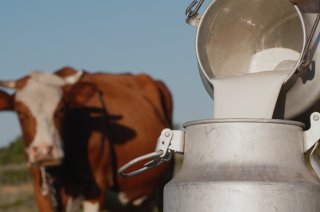
category_news
WUR is working with dairy supply chains to reduce carbon footprint of milk by 50%
Unilever (which works with Ben & Jerry’s and CONO Cheesemakers) and Nestlé (which works with Vreugdenhil Dairy Foods) both have programmes in place to make their respective dairy supply chains more sustainable and to achieve an ambitious goal: a 50% reduction in the carbon footprint of milk by 2030. The two chains have now joined forces with WUR to launch a four-year ‘Low Carbon Dairy’ public-private partnership (PPP) which will address a number of questions such as: what measures are required to achieve that objective? How do you come up with an appropriate plan that works for different types of businesses? What are the implications for the economy and other sustainability issues?
The two supply chains also aim to develop an approach that will be broadly applicable and accessible. The answers to the questions posed by the partnership will help it achieve its ambitious objectives.
Cooperation in the chain is needed
The dairy farmer need not and cannot do it alone; suppliers and other parties can also do their bit. The PPP therefore includes cooperation with a number of compound feed companies (Agrifirm, ForFarmers and De Heus), Duynie (supplier of co-products) and Lely (robots and data systems for dairy farms) and Rabobank. The dairy chains themselves are working with groups of dairy farmers. PPP- Agro Advies supports the dairy farmers in making their reduction plans.
How can a 50% reduction be achieved, and what does it mean?
The project and its participating partners are focusing on the following questions:
- What measures could be taken to achieve a 50% reduction, appropriate to individual businesses and business owners?
- What is the best way to develop an appropriate individual business plan, and how can the implementation of such plans be supported and progress monitored?
- What are the implications of a 50% reduction in greenhouse gases in relation to the economy and to other sustainability issues for different types of businesses?
A key principle of the project is that it should eventually lead to the development of an approach and associated instruments that can be scaled up to a large number of dairy farmers.
Same objective, but occasionally a different approach
The activities within both of the dairy supply chains provide the setting for developing an approach and instruments that can reduce greenhouse gas emissions. Both chains had already started working with a group of dairy farmers in 2022 to come up with reduction plans and to implement them. These plans include measures such as modifying rations, using grass/clover mixes, and manure fermentation. Innovations are also being tested and fully costed. The pilot farms are based on a variety of soil types (clay, peat, sand) and they are working with a range of strategies (from high-tech to nature inclusive). This diversity provides opportunities to find out which measures work best in which setting.
Research activities
The research approach in the first year will focus in particular on the following components:
- Further developing the approach to creating plans and monitoring progress. The applied approach will be evaluated and combined with the most up to date scientific insights around change processes. Scaling up is an important part of this.
- The ongoing development of the mitigation engine. The mitigation engine will be used to help create the plans. This is a tool that is fed with data specific to a particular business (drawn from the Annual Nutrient Cycling Assessment, or KringloopWijzer). It can be used by advisers when they work with dairy farmers to select measures appropriate to their particular businesses.
- Setting out the facts. Greenhouse gas emissions in dairy farming is still a relatively new topic. That means it’s useful to compile fact sheets that set out the facts around certain topics in a practical and accessible way. These could address new reduction measures, for example, and explain the underlying principle and how they work in specific settings. Another topic certain to be addressed is carbon sequestration and its associated challenges and opportunities.